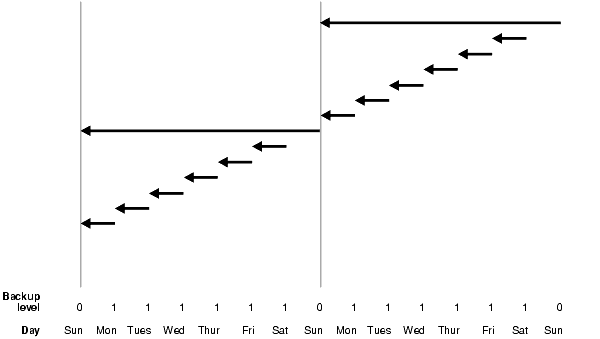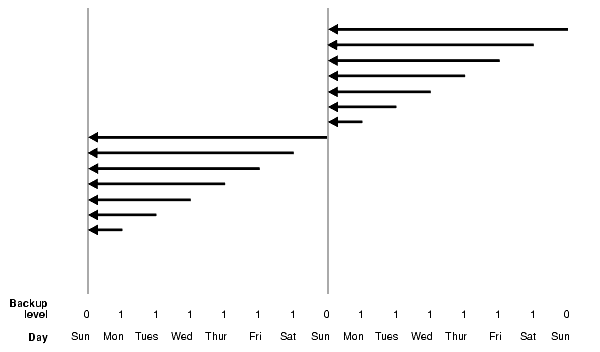| Oracle® Database Backup and Recovery Advanced User's Guide 10g Release 2 (10.2) Part Number B14191-02 |
|
|
View PDF |
| Oracle® Database Backup and Recovery Advanced User's Guide 10g Release 2 (10.2) Part Number B14191-02 |
|
|
View PDF |
As explained in Table 2-1, RMAN backups can be classified in these ways:
Full or incremental
Open or closed
Consistent or inconsistent
Note that these backup classifications apply only to datafile backups. Backups of other files, such as archivelogs and control files, always include the complete file and are never inconsistent.
Table 2-1 Backup Types
| Backup Type | Definition |
|---|---|
|
Full |
A backup of a datafile that includes every allocated block in the file being backed up. A full backup of a datafile can be an image copy, in which case every data block is backed up. It can also be stored in a backup set, in which case datafile blocks not in use may be skipped, according to rules in Oracle Database Backup and Recovery Reference. A full backup cannot be part of an incremental backup strategy; that is, it cannot be the parent for a subsequent incremental backup. |
|
Incremental |
An incremental backup is either a level 0 backup, which includes every block in the file except blocks compressed out because they have never been used, or a level 1 backup, which includes only those blocks that have been changed since the parent backup was taken. A level 0 incremental backup is physically identical to a full backup. The only difference is that the level 0 backup is recorded as an incremental backup in the RMAN repository, so it can be used as the parent for a level 1 backup. |
|
Open |
A backup of online, read/write datafiles when the database is open. |
|
Closed |
A backup of any part of the target database when it is mounted but not open. Closed backups can be consistent or inconsistent. |
|
Consistent |
A backup taken when the database is mounted (but not open) after a normal shutdown. The checkpoint SCNs in the datafile headers match the header information in the control file. None of the datafiles has changes beyond its checkpoint. Consistent backups can be restored without recovery. Note: If you restore a consistent backup and open the database in read/write mode without recovery, transactions after the backup are lost. You still need to perform an |
|
Inconsistent |
A backup of any part of the target database when it is open or when a crash occurred or An inconsistent backup requires recovery to become consistent. |
The goal of an incremental backup is to back up only those data blocks that have changed since a previous backup. You can use RMAN to create incremental backups of datafiles, tablespaces, or the whole database.
During media recovery, RMAN examines the restored files to determine whether it can recover them with an incremental backup. If it has a choice, then RMAN always chooses incremental backups over archived logs, as applying changes at a block level is faster than reapplying individual changes.
RMAN does not need to restore a base incremental backup of a datafile in order to apply incremental backups to the datafile during recovery. For example, you can restore non-incremental image copies of the datafiles in the database, and RMAN can recover them with incremental backups.
Incremental backups allow faster daily backups, use less network bandwidth when backing up over a network, and provide better performance when tape I/O bandwidth limits backup performance. They also allow recovery of database changes not reflected in the redo logs, such as direct load inserts. Finally, incremental backups can be used to back up NOARCHIVELOG databases, and are smaller than complete copies of the database (though they still require a clean database shutdown).
One effective strategy is to make incremental backups to disk (as image copies), and then back up these image copies to a media manager with BACKUP AS BACKUPSET. Then, you do not have the problem of keeping the tape streaming that sometimes occurs when making incremental backups directly to tape. Because incremental backups are not as big as full backups, you can create them on disk more easily.
Each data block in a datafile contains a system change number (SCN), which is the SCN at which the most recent change was made to the block. During an incremental backup, RMAN reads the SCN of each data block in the input file and compares it to the checkpoint SCN of the parent incremental backup. (If block change tracking is enabled, RMAN does not read the portions of the file known to have not changed since the parent incremental backup.) If the SCN in the input data block is greater than or equal to the checkpoint SCN of the parent, then RMAN copies the block.
One consequence of this mechanism is that RMAN applies all blocks containing changed data during recovery—even if the change is to an object created with the NOLOGGING option. Hence, making incremental backups is a safeguard against the loss of changes made by NOLOGGING operations.
RMAN can create multilevel incremental backups. Each incremental level is denoted by a value of 0 or 1. A level 0 incremental backup, which is the base for subsequent incremental backups, copies all blocks containing data. The only difference between a level 0 incremental backup and a full backup is that a full backup is never included in an incremental strategy.
A level 1 incremental backup can be either of the following types:
A differential backup, which backs up all blocks changed after the most recent incremental backup at level 1 or 0
A cumulative backup, which backs up all blocks changed after the most recent incremental backup at level 0
Incremental backups are differential by default.
Note:
Cumulative backups are preferable to differential backups when recovery time is more important than disk space, because fewer incremental backups need to be applied during recovery.The size of the backup file depends solely upon the number of blocks modified and the incremental backup level.
In a differential level 1 backup, RMAN backs up all blocks that have changed since the most recent incremental backup at level 1 (cumulative or differential) or level 0. For example, in a differential level 1 backup, RMAN determines which level 1 backup occurred most recently and backs up all blocks modified after that backup. If no level 1 is available, RMAN copies all blocks changed since the base level 0 backup.
If no level 0 backup is available, then the behavior varies with the compatibility mode setting. If compatibility is >=10.0.0, RMAN copies all blocks that have been changed since the file was created. Otherwise, RMAN behaves as it did in previous releases, by generating a level 0 backup.
Figure 2-4 Differential Incremental Backups

In the example shown in Figure 2-4, the following occurs each week:
Sunday
An incremental level 0 backup backs up all blocks that have ever been in use in this database.
Monday - Saturday
On each day from Monday through Saturday, a differential incremental level 1 backup backs up all blocks that have changed since the most recent incremental backup at level 1 or 0. The Monday backup copies blocks changed since Sunday level 0 backup, the Tuesday backup copies blocks changed since the Monday level 1 backup, and so forth.
In a cumulative level 1 backup, RMAN backs up all the blocks used since the most recent level 0 incremental backup. Cumulative incremental backups reduce the work needed for a restore by ensuring that you only need one incremental backup from any particular level. Cumulative backups require more space and time than differential backups, however, because they duplicate the work done by previous backups at the same level.
Figure 2-5 Cumulative Incremental Backups

In the example shown in Figure 2-5, the following occurs each week:
Sunday
An incremental level 0 backup backs up all blocks that have ever been in use in this database.
Monday - Saturday
A cumulative incremental level 1 backup copies all blocks changed since the most recent level 0 backup. Because the most recent level 0 backup was created on Sunday, the level 1 backup on each day Monday through Saturday backs up all blocks changed since the Sunday backup.
Choose a backup scheme according to an acceptable MTTR (mean time to recover). For example, you can implement a three-level backup scheme so that a full or level 0 backup is taken monthly, a cumulative level 1 is taken weekly, and a differential level 1 is taken daily. In this scheme, you never have to apply more than a day's worth of redo for complete recovery.
When deciding how often to take full or level 0 backups, a good rule of thumb is to take a new level 0 whenever 20% or more of the data has changed. If the rate of change to your database is predictable, then you can observe the size of your incremental backups to determine when a new level 0 is appropriate. The following query displays the number of blocks written to a backup set for each datafile with at least 50% of its blocks backed up:
SELECT FILE#, INCREMENTAL_LEVEL, COMPLETION_TIME, BLOCKS, DATAFILE_BLOCKS FROM V$BACKUP_DATAFILE WHERE INCREMENTAL_LEVEL > 0 AND BLOCKS / DATAFILE_BLOCKS > .5 ORDER BY COMPLETION_TIME;
Compare the number of blocks in differential or cumulative backups to a base level 0 backup. For example, if you only create level 1 cumulative backups, then take a new level 0 backup when the most recent level 1 backup is about half of the size of the base level 0 backup.
See Also:
Oracle Database Backup and Recovery Basics to learn how make incremental backups